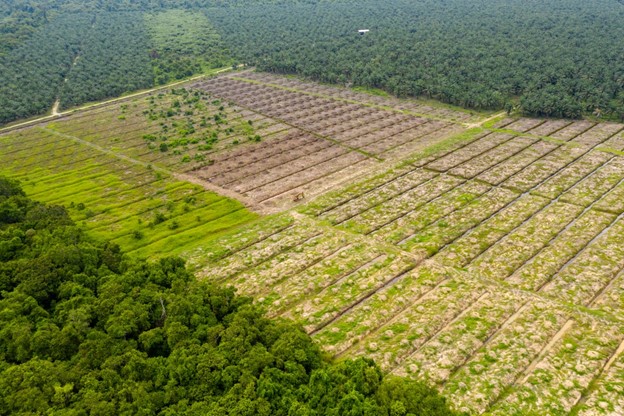Deforestation is a critical environmental challenge, with agricultural expansion being a leading cause. This phenomenon is not only a significant driver of climate change but also a major threat to global biodiversity, leading to an unprecedented rate of species extinction. Carbon Green Investments delves into the intricate relationship between agriculture and deforestation, it is crucial to emphasize the imperative of integrating biodiversity preservation into agricultural practices. This approach is vital for sustaining the planet’s health, and the myriad of life forms it supports.
The Agriculture-Deforestation Nexus
Deforestation for agricultural purposes involves converting forests into farmland for crops or pasture. As global populations swell and the demand for food increases, this practice has become increasingly prevalent.
Palm Oil Production: An Unsustainable Growth
Palm oil, derived from the oil palm tree, is a prime culprit in rainforest destruction. It’s found in a myriad of products, from processed foods to cosmetics. However, the expansion of palm oil plantations, especially in Southeast Asia, has led to the destruction of rich, biodiverse rainforests. This not only devastates habitats but also threatens the survival of countless species. The process typically involves clearing vast tracts of forest, often through burning, which releases significant amounts of carbon dioxide into the atmosphere. The resulting plantations are ecological deserts compared to the rich biodiversity of the natural forests they replace.
Cattle Ranching the Amazon Deforestation
Cattle ranching, particularly in the Amazon rainforest, is another significant contributor to deforestation. The Amazon is not only a critical carbon sink but also a biodiversity haven. The increasing global demand for beef has led to the extensive clearing of these forests for cattle grazing. This practice not only reduces the forest’s capacity to sequester carbon but also leads to soil degradation and the loss of habitats for local species.
The Crisis of Biodiversity Loss
Deforestation’s most immediate and severe impact is the loss of biodiversity. Tropical rainforests, such as those in the Amazon and Indonesia, are home to over half of the world’s species. The clearing of these forests for agriculture leads to the extinction of numerous species, many of which are unique to these habitats.
The Disruption of Ecosystem Services
Forests provide crucial ecosystem services like carbon storage, oxygen production, soil conservation, and water cycle regulation. The conversion of forests to agricultural land directly disrupts these services. This not only exacerbates climate change, but also leads to further environmental degradation, such as soil erosion and decreased water quality.
Socio-Economic Impacts
The effects of deforestation extend to social and economic realms as well. Indigenous communities, often reliant on forests for their livelihoods and cultural heritage, are displaced or deprived of their resources. Furthermore, the global market’s reliance on products like palm oil and beef creates a link between consumer choices in distant countries and deforestation, presenting a complex interplay of economic, ethical, and environmental issues.
Strategies for Mitigation
Addressing the issue of agriculture-induced deforestation requires a comprehensive approach that encompasses sustainable farming, consumer awareness, policy interventions, and technological innovation.
- Sustainable Agricultural Practices: Transitioning to sustainable farming methods can significantly mitigate deforestation. Practices like agroforestry, which integrates trees into agricultural systems, organic farming, and sustainable cattle ranching are key. These practices not only help to preserve biodiversity, but also maintain soil health and reduce carbon emissions.
- Consumer Awareness and Choices: Educating consumers about the environmental impact of their purchasing decisions is crucial. Promoting a demand for sustainably sourced products can influence the practices of major agricultural producers. Labels such as “Rainforest Alliance Certified” or “Certified Sustainable Palm Oil” help consumers make better informed choices.
- Policies and Regulations: Effective governmental policies and international agreements play a vital role in controlling land use and promoting sustainable practices. This includes enforcing laws against illegal deforestation, providing incentives for sustainable agriculture, and setting up protected areas.
- Technological Innovations: Advances in technology can significantly reduce the agricultural sector’s reliance on deforestation. Precision agriculture, as in using tools like GPS and satellite imagery, enables farmers to maximize yield while minimizing land use. Additionally, developing alternative, sustainable materials to palm oil and beef can reduce the pressure on forests.
The role of agriculture in deforestation is a complex issue with deep environmental, economic, and social roots. Addressing it requires a multi-faceted approach involving sustainable agricultural practices, informed consumer behavior, strong policies, and innovative technology. Balancing the growing global food demands with the imperative to preserve our planet’s biodiversity and ecosystems is a challenge that calls for immediate and concerted worldwide action. The future health of our planet and the survival of countless species depend on the choices we make today.
